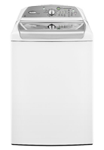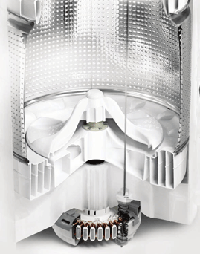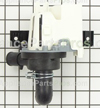Whirlpool Cabrio Washer Parts Information

(Note: Click on a part image for pricing information. Because of minor differences from one washer model to another, you will need to use your washing machine's full model number when ordering repair parts.)
Whirlpool Cabrio Washing Machine Components
Drive Motor

The drive motor on the Whirlpool Cabrio washing machines is two part system made of a stator which generates a rotating magnetic field and a rotor with strong permanent magnets embedded around it's inner wall allowing it to levitate over the stator. When the control board energizes the fixed position stator the rotor begins to rotate, attempting to equalize in the moving magnetic field. This style of motor operates with almost zero mechanical friction, and can accelerate, stop, and reverse direction faster than you can say, "mama needs a new washer".

The Rotary Position Sensor or "RPS" monitors the motor's direction and rotation speed, then relays the information to the washer's control board. This is an extremely reliable motor design and most problems that happen are control related. Some of the first Cabrio washers had an invisible coating on the motor's RPS connection remaining from production that would block communication from the RPS to the control board causing RPS related error codes. Unplugging and reconnecting the RPS connection plug several times to clean off the coating for better contact would easily fix the problem. To test the motor windings for resistance disconnect the wire connector from the drive motor terminals, and measure across any two of the three drive motor terminals. Resistance should be about 16 Ω for each one of the three stator motor coils. You can also measure from the wires connected to the P5 terminal of the washing machines control board.
(How to Use a Voltmeter)
Note: if an abnormal reading is measured from the P5 control board of the washing machine be sure to test the motor directly before drawing a conclusion, this will eliminate the wiring harness as a possible problem.
Fun Fact: This style of washing machine motor can also be used to create a windmill or water mill electricity generator! (This will probably void your washing machine's warranty.)
You could always buy a new stator and rotor from AppliancePartsPros.com through the stator and rotor image links above so that I can feed my family. : )
Back to Top
Impeller/ Agitator
Impeller Definition: The rotating part or a pump, compressor, or other machine designed to move fluid by rotation.

Click For Agitator Repair Parts
Agitator Definition: An apparatus for stirring liquid.
The Whirlpool Cabrio come in two basic flavors, one with an agitator and the other with an impeller. The impeller or agitator is directly attached to the motor rotor by a short drive shaft that is embedded with a bearing through the bottom of the outer tub. The rotor will turn the agitator or impeller causing the clothing to move through the wash water in one direction. Because the inner tub is floating in the wash water it will begin to move in the same direction due to the friction generated by the motion of water or clothing. The rotor will then change direction causing the impeller to also change direction and spin beneath the clothing like a super gentle washboard. (This action may be a little on the weak side leading to less than satisfactory washing results.)
The agitator style will pause for a moment while the drive shaft spins in the counter clockwise direction, because of a ratcheting system inside the agitator that will only allow it to be driven in one direction. When the rotor reverses direction four "roller cams" inside the agitator retract releasing it from the drive shaft until it again changes direction for the clockwise stroke. (This washing machine style requires more water to operate, is less gentle on clothing, and has reduced capacity because of space taken up by the agitator. However, many people prefer this style to the impeller models because of better washing results.)
Note: The Impeller or agitator can be removed from the washing machine by pulling the top cap off of the impeller or agitator and removing the 7/16" bolt that is hidden underneath. This will allow you to examine and replace the agitator roller cams or lift the inner wash basket out to access the outer tub, tub sump, and lint filter for cleaning.
Recirculation Pump
The recirculation pump is the key to the Whirlpool Cabrio water sipping efficiency. Instead of completely filling the washing machine's tub like most top loading washing machines, only enough water is added to cover the washer's wash plate and float the inner tub allowing it to lift off the basket hub. Once the washing machine has finished adding water to the washtub the recirculation pump jumps into action recycling wash water back on top of the clothing.

The recirculation pump is located at the left rear of the washing machine mounted directly to the outer washtub with three 5/16" hex-head screws. Like all washing machines it is important to check your pockets for loose change and put smaller items such as baby socks and lingerie into a mesh laundry bag to keep them from finding their way into the washer's recirculation pump or drain pump.
Note: Don't wash floor rugs with rubber backing in your fancy washing machine!
If the recirculation pump motor becomes clogged it can often be cleared of the object and reinstalled. However, motor damage can occur if the motor is allowed to operate that way for a long period of time. The pump motor windings should have a resistance value between 30-38 Ω and can be tested for resistance directly at the pump or by testing the wires connected to the pump after disconnecting them from the P4 connection on the washer's control board.
Note: if a resistance problem is detected at the P4 control board connection, be sure to check the recirculation pump directly before ordering a new pump, this will eliminate possible problems with the wiring harness. Also be sure to check all of the connected hoses and the tub sump area for blockages.
Note: The Recirculation pump can be manually tested with the diagnostic tests.
(How to Use a Voltmeter)
Back to Top
More